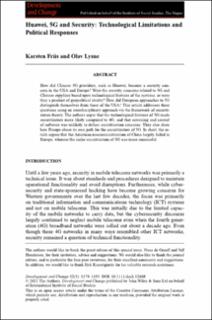| dc.contributor.author | Friis, Karsten | |
| dc.contributor.author | Lysne, Olav | |
| dc.coverage.spatial | China | en_US |
| dc.date.accessioned | 2021-10-27T14:41:55Z | |
| dc.date.available | 2021-10-27T14:41:55Z | |
| dc.date.created | 2021-09-21T14:07:52Z | |
| dc.date.issued | 2021-10-03 | |
| dc.identifier.citation | Development and Change. 2021, 52 (5), 1174-1195. | en_US |
| dc.identifier.issn | 0012-155X | |
| dc.identifier.issn | 1467-7660 | |
| dc.identifier.uri | https://hdl.handle.net/11250/2826071 | |
| dc.description.abstract | How did Chinese 5G providers, such as Huawei, become a security concern in the USA and Europe? Were the security concerns related to 5G and Chinese suppliers based upon technological features of the systems, or were they a product of geopolitical rivalry? How did European approaches to 5G distinguish themselves from those of the USA? This article addresses these questions using an interdisciplinary approach via the framework of securitization theory. The authors argue that the technological features of 5G made securitization more likely compared to 4G, and that screening and control of software was unlikely to defuse securitization concerns. They also show how Europe chose its own path for the securitization of 5G. In short, the article argues that the American macrosecuritization of China largely failed in Europe, whereas the niche securitization of 5G was more successful. | en_US |
| dc.language.iso | eng | en_US |
| dc.publisher | Wiley | en_US |
| dc.relation.ispartofseries | Development and Change;Volume 52, Issue 5, Special Issue: The Wind from the East: China and the Economic Future of Europe | |
| dc.rights | Navngivelse 4.0 Internasjonal | * |
| dc.rights.uri | http://creativecommons.org/licenses/by/4.0/deed.no | * |
| dc.subject | Europa | en_US |
| dc.subject | Europe | en_US |
| dc.subject | Sikkerhetspolitikk | en_US |
| dc.subject | Security policies | en_US |
| dc.subject | Internasjonale investeringer | en_US |
| dc.subject | International investments | en_US |
| dc.subject | Nord-Amerika | en_US |
| dc.subject | North America | en_US |
| dc.title | Huawei, 5G and Security: Technological Limitations and Political Responses | en_US |
| dc.type | Peer reviewed | en_US |
| dc.type | Journal article | en_US |
| dc.description.version | publishedVersion | en_US |
| dc.rights.holder | © 2021 The Authors | en_US |
| cristin.ispublished | true | |
| cristin.fulltext | original | |
| cristin.qualitycode | 2 | |
| dc.identifier.doi | https://doi.org/10.1111/dech.12680 | |
| dc.identifier.cristin | 1936617 | |
| dc.source.journal | Development and Change | en_US |
| dc.source.volume | 52 | en_US |
| dc.source.issue | 5 | en_US |
| dc.source.pagenumber | 1174-1195 | en_US |
| dc.relation.project | Norges forskningsråd: 288744 | en_US |
| dc.subject.nsi | VDP::Internasjonal politikk: 243 | en_US |
| dc.subject.nsi | VDP::International politics: 243 | en_US |

